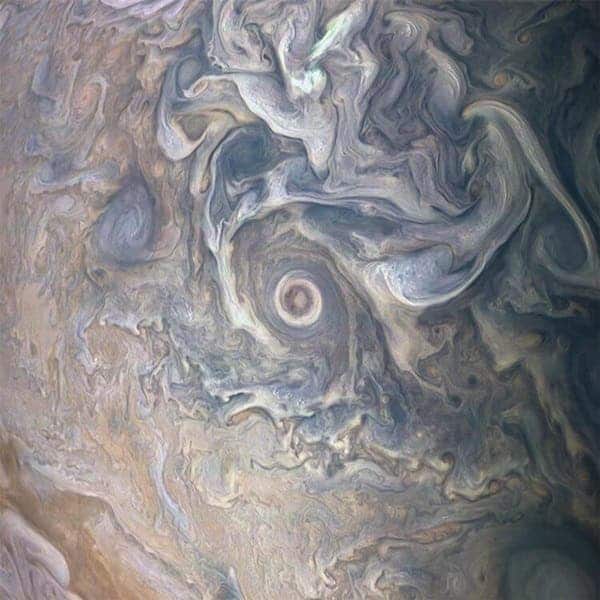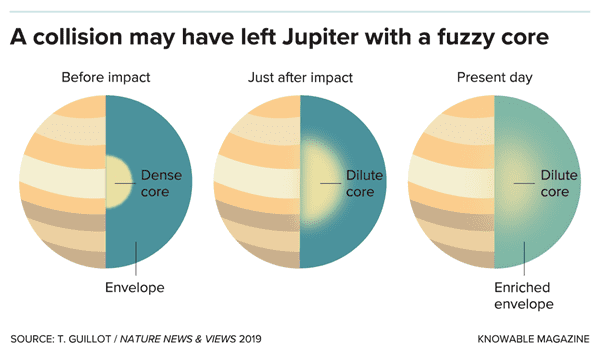Jupiter is sometimes called a ‘failed star’ for good reason. The gas giant is the largest planet in the solar system by a large margin and is primarily composed of hydrogen and helium — just like the sun. But despite the fact it’s 318 times bigger than Earth, Jupiter isn’t massive enough for gravity to trigger nuclear fusion, which would have elevated it to stellar status.

The fifth planet from the sun has an atmosphere composed of about 90% hydrogen and about 10% helium, with trace amounts of other gases. These include water vapor, methane, hydrogen sulfide, neon, oxygen, phosphine, carbon, ethane, sulfur, and ammonia crystals, according to spectral analyses of the planet.
The atmosphere is not uniform with the gases being piled on top of one another, forming multiple layers extending downward, including a layer of supercritical hydrogen (the point where distinct liquid and gas phases do not exist).
These layers aren’t necessarily linked to Jupiter’s famous stripes. These are actually the result of a combination of a fast rotation of the planet and dramatic differences in temperature in various regions. Earth rotates once in 24 hours, whereas Jupiter rotates once in about 9.5 hours. However, the surface of Earth at the equator is rotating at about 1000 miles per hour, while Jupiter’s equatorial cloud-tops are moving nearly 28,000 miles per hour. Jupiter’s equator is also more intensely heated than at the poles. The physics responsible for Jupiter’s stripes is actually quite similar to that responsible for trade winds near the equator and jet streams near the poles on Earth.
But unlike Earth, Jupiter doesn’t have a solid surface, so a visitor traveling through the Jovian atmosphere in a spacecraft would simply plow through like a knife through the mist. However, for practical purposes, scientists consider Jupiter’s surface the geodesic line where the atmospheric pressure is equal to that of Earth at sea level — at this point, gravity is 2.5 times more powerful than on Earth.
However, this hypothetical spacecraft wouldn’t just end up on the other side of the planet if it kept zipping through in a straight line — at some point, it would crash into Jupiter’s core, estimated to be about 35,000 degrees Celsius (63,000 degrees Fahrenheit).
Does Jupiter have a solid core?
Scientists still aren’t sure what this core looks like since the dense and swirling clouds obstruct observations. But there are reasons to believe Jupiter has a dense rocky center enveloped in a layer of metallic hydrogen (a phase of hydrogen in which it behaves like an electrical conductor), with another layer of molecular hydrogen (regular H2, dihydrogen gas) on top.
The presence of a rocky core is also supported by models of planetary formation which show that a rocky core, or at the very least an icy one, would have been necessary at some point in the gas giant’s history.
According to a 1997 study, which performed gravitational measurements, Jupiter’s core could have a mass of 12 to 45 times the mass of planet Earth — that’s 4% to 14% of Jupiter’s total mass.
Another school of thought concerning Jupiter’s core suggests that the gas giant lacks a rocky core. Instead, when the planet formed billions of years ago, a pocket of gas simply collapsed in on itself, creating a more-or-less pure hydrogen-helium world.
But this latter hypothesis has since been dispelled by the Juno mission. Launched in August 2011, the spacecraft named after Jupiter’s wife in Roman mythology has revealed numerous secrets about Jupiter.
By measuring how the spacecraft’s velocity was ramped up or slowed down by the planet’s gravitational field, scientists could deduce how mass is distributed in Jupiter’s depths. Although there’s no way to peer through Jupiter’s swirling dense clouds, this clever method confirmed that Jupiter does indeed have a core, scientists wrote in the journal Nature. What’s more, rather than being a compact ball, the analysis showed that the core is more like a fuzzy sphere spread across nearly half of Jupiter’s diameter.

Scientists don’t actually know why Jupiter has such an atypical core, but whatever the explanation may be, it’s telling of how the planet formed. One possible explanation is that early Jupiter was stirred up by the impact with another huge proto-planetary body. Another explanation would be that Jupiter changed orbit and added more planetesimals early in its history.
Nevertheless, this insight showed that we still don’t know much about giant gas planets. Besides overturning assumptions about Jupiter’s core, the Juno mission also showed that the strange clusters of cyclones raging around the planet’s north and south poles are more chaotic than previously thought. Another surprise was Jupiter’s magnetic field, which turned out to be twice as strong than scientists assumed.
As Juno continues its mission exploring Jupiter and its moons, NASA scientists hope to uncover strange new things about Jupiter.


